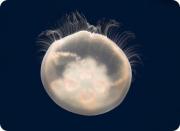Radio Program
Our regular Science and the SeaTM radio program presents marine science topics in an engaging two-minute story format. Our script writers gather ideas for the radio program from the University of Texas Marine Science Institute's researchers and from our very popular college class, Introduction to Oceanography, which we teach to hundreds of non-science majors at The University of Texas at Austin every year. Our radio programs are distributed at to commercial and public radio stations across the country.
The earliest life in the oceans wasn’t a fish or a mammal. It didn’t have a shell or tentacles. And instead of eating the other organisms around it, it made its own food from its environment. Yet without it, the complex life forms of today -- in the oceans and on land -- wouldn’t exist at all.
The record of this early life is preserved in layered rocks known as stromatolites. They were built one tiny layer at a time by microbes -- the first life on Earth.
As nicknames go, “kidneys of the coast” isn’t the most appetizing. And when you consider that it applies to places like swamps, bogs, and marshes, it’s even less appealing. Yet these areas really are important to the health of coastal regions. Known as coastal wetlands, they purify the water, control erosion, and offer habitat for hundreds of species of life.
When a modern-day ship glides across the oceans, it’s guided in large part by satellites -- the Global Positioning System. They reveal the ship’s position to within a few feet.
When early explorers began heading across the oceans, though, they were guided in large part by the stars -- a method that often led them dangerously off course.
The earliest sailors were guided by the coastline. When they began to venture out to sea, they relied on the position of the Sun, the ocean currents, and even the birds to keep them on course.
It sounds like something that’s advertised in the back of a comic book: a flashlight that only you and your family can see, allowing you to send messages and identify friend and foe in the dark!
But this flashlight is found on the face of one of the scariest-looking creatures in the deep ocean: a black dragonfish. It’s not very big, but it has a wide mouth filled with long, sharp teeth.
There are several species of dragonfish, and like most other deep-sea organisms, they produce their own light to help them find prey, avoid predators, and attract mates.
When a powerful tsunami slammed into the coast of India in December of 2004, it killed thousands. Yet even though it was directly in the tsunami’s path, the town of Pondicherry was spared -- protected by a seawall that was started by French engineers almost three centuries earlier.
Seawalls have been protecting coastal settlements for thousands of years. They can prevent flooding during hurricanes, and prevent the beach from eroding into the sea.
When a starfish moves along the bottom of the ocean, it almost looks like it’s gliding. It’s not, though -- it’s walking on hundreds of tiny “legs” that are powered by seawater.
The starfish -- more correctly known as a sea star -- is propelled by a network of water-filled tubes and sacs known as the water vascular system. Water enters the sea star through an opening located between two of the creature’s five “arms.” A sieve-like structure inside this opening filters out solid particles.
Shark Bay, at the westernmost tip of Australia, is like a land that time forgot. It’s home to a host of plant species that are found nowhere else, several endangered species of mammals, and rock-building microbes like those that inhabited Earth three-and-a-half billion years ago. What it doesn’t have much of is people, and that’s one reason why it has so much of everything else.
The region covers several thousand square miles. It’s far away from any big cities, and only a couple of thousand people live along its thousand miles of coastline.
Marine organisms have many ways of getting around. They wiggle, flap, crawl, or undulate. And some go high-tech: they use jet propulsion.
The marine jet set includes jellyfish, squid, and octopus. All of them create jet thrust by squirting water at high speed, like compressed air squirting out the back of a jet engine.
The deadliest hurricane in U.S. history slammed into Galveston, Texas, on September 8th, 1900. It killed an estimated 8,000 people. Despite its infamy, though, there’s no formal name for the hurricane. At the time, there was no procedure for naming such storms.
It’s almost not fair. The top predators in the oceans -- great white sharks and some of their kin -- have an extra sense to help them find and track prey: the ability to detect the tiny electrical fields that are generated by all living organisms.
Most sharks have keen senses that allow them to track prey, predators, and mates at varying distances. At close range, they also rely on a network of sensors known as ampullae of Lorenzini, named for the Italian scientist who discovered them more than three centuries ago.


